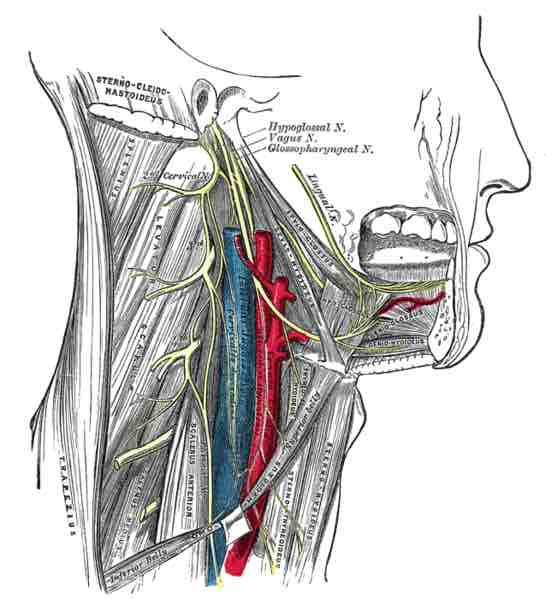Structure
The glossopharyngeal nerve is the ninth of 12 pairs of cranial nerves. It exits the brainstem out from the sides of the upper medulla, just rostral (closer to the nose) to the vagus nerve.
The motor division of the glossopharyngeal nerve is derived from the basal plate of the embryonic medulla oblongata, while the sensory division originates from the cranial neural crest.

Glossopharyngeal nerve
Image of head structures including the glossopharyngeal nerve.
Function
There are a number of functions of the glossopharyngeal nerve. It controls muscles in the oral cavity and upper throat, as well as part of the sense of taste and the production of saliva.
Along with taste, the glossopharyngeal nerve relays general sensations from the pharyngeal walls. The various functions of the glossopharyngeal nerve are that:
- It receives general sensory fibers (ventral trigeminothalamic tract) from the tonsils, the pharynx, the middle ear, and the posterior 1/3 of the tongue.
- It receives special sensory fibers (taste) from the posterior 1/3 of the tongue.
- It receives visceral sensory fibers from the carotid bodies, carotid sinus.
- It supplies parasympathetic fibers to the parotid gland via the otic ganglion.
- It supplies motor fibers to the stylopharyngeus muscle.
- It contributes to the pharyngeal plexus.
Five Functional Components
The glossopharyngeal nerve consists of five components with distinct functions:
- Branchial motor (special visceral efferent): Supplies the stylopharyngeus muscle.
- Visceral motor (general visceral efferent): Provides parasympathetic innervation of the parotid gland.
- Visceral sensory (general visceral afferent): Carries visceral sensory information from the carotid sinus and body.
- General sensory (general somatic afferent): Provides general sensory information from the skin of the external ear, internal surface of the tympanic membrane, upper pharynx, and the posterior 1/3 of the tongue.
- Special sensory (special afferent): Provides taste sensation from the posterior 1/3 of the tongue.